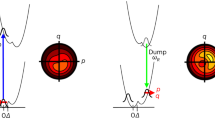Abstract.
A femtosecond UV laser pulse is used to resonantly excite CsCl molecules from the ionically bound ground state to the first excited repulsive state. The excitation leads to the dissociation of CsCl. After a certain time delay a visible (VIS) femtosecond laser pulse interrupts the dissociation process by resonantly de-exciting the molecule back to the ground state. According to the Tannor–Rice control scheme, the fraction of dissociated CsCl molecules is controlled by changing the delay time between the two fs laser pulses. The processes involved are investigated theoretically and experimentally. Based on the results, a self-learning system has been realized, which is able to control the dissociation without any a priori knowledge of the molecule.
Similar content being viewed by others
Author information
Authors and Affiliations
Additional information
Received: 2 December 1999 / Published online: 24 July 2000
Rights and permissions
About this article
Cite this article
Glass, A., Rozgonyi, T., Feurer, T. et al. Control of the photodissociation of CsCl . Appl Phys B 71, 267–276 (2000). https://doi.org/10.1007/s003400000397
Published:
Issue Date:
DOI: https://doi.org/10.1007/s003400000397



